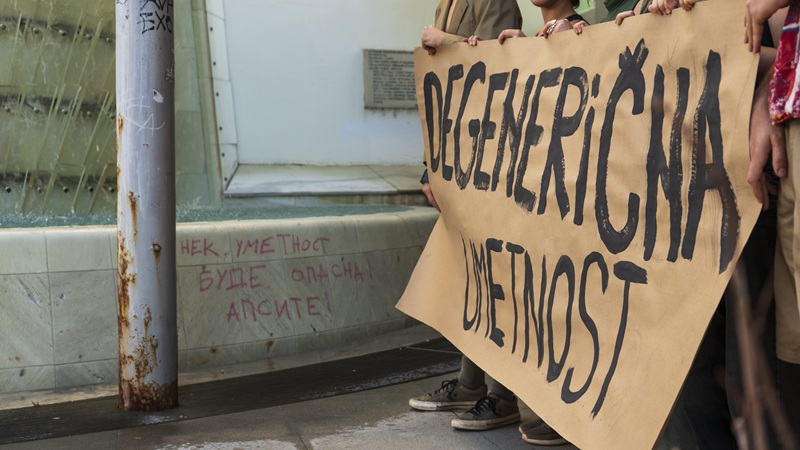08 2025
An exhibition of "degenerate art" at the Student Cultural Center in Belgrade?!
One month after the police and administration cleared the building, accompanied by the regime media, students who had occupied the Student Cultural Center (SKC) in Belgrade for more than five months unrolled a banner in front of the SKC building with the words "DEGENERATE ART" as a comment on the current exhibition organized by the new administration and the regime.
The moment the monopoly on truth is lost and the former authority begins to show cracks that must somehow be filled so that this weak, fragile authority structure does not collapse completely, the need arises to create a narrative that produces a divided image of remembrance in the collective memory.
However, this narrative quickly turns into a very dangerous game for its "narrator" and always ends in the same way. The instrumentalization of cultural-historical manipulation for political or ideological purposes has always been a feature of imperialist, authoritarian, and right-wing attempts to create a fake cultural model.
In search of a way out of their own precarious situation, the SKC management, under acting director Slavoljub Veselinović, opened the exhibition “Looking to the Future”, which is intended to portray the student blockade as social decay.
History spares no one. And art history teaches all those who try to misuse it for manipulative purposes.
With its attempt to frame the contents of the student blockade as "degenerate," the SKC leadership, consciously or unconsciously, fell into a historical trap and practically created its own version of the infamous exhibition "Degenerate Art"—one of the greatest missteps by a government in the history of art and culture.
The exhibition "Degenerate Art" opened in Munich in 1937 as part of the Nazi regime's propaganda campaign against modernist and avant-garde movements in art. Organized at the behest of Propaganda Minister Joseph Goebbels, the exhibition aimed to publicly discredit works considered "degenerate"—from Expressionism and Dadaism to Surrealism and Abstraction. Everything subversive and critical was exposed. The artworks were presented in a chaotic manner, with mocking inscriptions and propagandistic comments to instill a feeling of contempt in visitors (we can see something similar this year at the Student Cultural Center in Belgrade). Works by leading European artists hung on the walls, including works by Klee, Chagall, and Nolde, as well as works by German artists who did not conform to the official ideology (similar to today, where, apart from during the brief period of the student occupation of the SKC, there is no publicly exhibited criticism of the prevailing ideology).
The essence of this exhibition lay not only in cultural oppression, but also in ideological manipulation. The Nazi regime used art as a means of defining and controlling cultural identity, determining what was "acceptable" and "pure" and what was considered dangerous to the people and the state. In this way, "degenerate art" became a paradigm of censorship and the abuse of art for political purposes. Ironically, thanks to this campaign, many of these works later received even greater international attention and became a symbol of resistance against the authoritarian interpretation of culture.
Unfortunately, an exhibition such as the current one on "Looking to the Future" at the SKC, which serves exclusively propaganda purposes, is no exception in national history. During the puppet government of National Salvation under Milan Nedić (1941-1944), similar propaganda exhibitions were organized in Belgrade, discrediting "undesirable" social actors and inciting hatred and contempt, and were funded with German (Nazi) money.
The avant-garde scene disappeared from the SKC for many years, not because it did not exist in Belgrade, but because it was indirectly admitted that art can be dangerous. It can be dangerous for you, your privileges, and your incompetence. You are afraid.
You are afraid of the new, of the avant-garde, you are afraid of art as such, because at some point it will reveal your true face.
Art will always outlive you. The brute fear of losing your monopoly has brought you into this situation, which you yourselves have created. It is our duty to show you where you have ended up. Welcome, dear SKC leadership, to the exhibition—the testimony of your crimes. Art history, as susceptible to manipulation as it may be, remembers everything. And it will remember this too.


